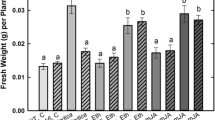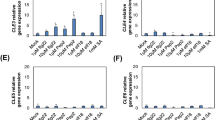Abstract
The symbiotic association of Piriformospora indica provides growth promotion leading to increased biomass as well as enhanced plant tolerance to biotic and abiotic stresses in a variety of plant species. Since various protein kinases are thought to be involved in mutual signaling in symbiotic interactions, we analyzed transcript profile of rice protein kinase genes during the infection process by real-time PCR. A rice L-type lectin protein kinase (OslecRK) and Arabidopsis AtLecRK genes are highly upregulated in roots during the initial stage of symbiotic association. In order to investigate the role of LecRK gene in root colonization, the Arabidopsis mutant line (Atlecrk) of rice homolog was used which shows the restricted intracellular penetration of the P. indica hyphae. The results indicate that LecRK might be a crucial factor in perception and recognition during plant–P. indica association by regulating fungal invasion.






Similar content being viewed by others
References
Afzal AJ, Wood AJ, Lightfoot DA (2008) Plant receptor-like serine threonine kinases: roles in signaling and plant defense. Mol Plant Microbe Interaction 21:507–517
Baluška F, Šamaj J, Wojtaszek P, Volkmann D, Menzel D (2003) Cytoskeleton-plasma membrane-cell wall continuum in plants: emerging links revisited. Plant Physiol 133:482–491
Barre A, Hervè C, Lescure B, Rouge P (2002) Lectin receptor kinases in plants. Crit Rev Plant Sci 21:379–399
Bouwmeester K, Govers F (2009) Arabidopsis L-type lectin receptor kinases: phylogeny, classification and expression profiles. J Exp Bot 60:4383–4396
Bouwmeester K, de Sain M, Weide R, Gouget A, Klamer S, Canut H, Govers F (2011) The lectin receptor kinase LecRK-I.9 is a novel Phytophthora resistance component and a potential host target for a RXLR effector. PLoS Pathog 7:e1001327
Brechenmacher L, Weidmann S, van Tuinen D, Chatagnier O, Gianinazzi S, Franken P, Gianinazzi-Pearson V (2004) Expression profiling of up-regulated plant and fungal genes in early and late stages of Medicago truncatula-Glomus mosseae interactions. Mycorrhiza 14:253–262
Camehl I, Drzewiecki C, Vadassery J, Shahollari B, Sherameti I, Forzani C, Munnik T, Hirt H, Oelmüller R (2011) The OXI1 kinase pathway mediates Piriformospora indica-induced growth promotion in Arabidopsis. PLoS Pathog 7:e1002051
Deshmukh S, Hückelhoven R, Schäfer P, Imani J, Sharma M, Waller F, Kogel KH (2006) The root endophytic fungus Piriformospora indica requires host cell death for proliferation during mutualistic symbiosis with barley. Proc Natl Acad Sci U S A 103:18450–18457
Giovannetti M, Mosse B (1980) An evaluation of techniques for measuring vesicular arbuscular mycorrhizal infection in roots. New Phytol 84:489–500
Gouget A, Senchou V, Govers F, Sanson A, Barre A, Rouge P, Pont-Lezica R, Canut H (2006) Lectin receptor kinases participate in protein-protein interactions to mediate plasma membrane-cell wall adhesions in Arabidopsis. Plant Physiol 140:81–90
Harrison MJ (2005) Signaling in the arbuscular mycorrhizal symbiosis. Annu Rev Microbiol 59:19–42
Hasegawa PM, Bressan RA, Zhu JK, Bohnert HJ (2000) Plant cellular and molecular responses to high salinity. Annu Rev Plant Physiol Plant Mol Biol 51:463–499
Hervé C, Serres J, Dabos P, Canut H, Barre A, Rougé P, Lescure B (1999) Characterization of Arabidopsis lecRK-a genes: members of a superfamily encoding putative receptors with an extracellular domain homologous to legume lectins. Plant Mol Biol 39:671–682
Hill TW, Kaefer E (2001) Improved protocols for Aspergillus medium: trace elements and minimum medium salt stock solutions. Fungal Genet Newslett 148:20–21
Jacobs S, Zechmann B, Molitor A, Trujillo M, Petutschnig E, Lipka V, Kogel KH, Schäfer P (2011) Broad-spectrum suppression of innate immunity is required for colonization of Arabidopsis roots by the fungus Piriformospora indica. Plant Physiol 156:726–740
Kanazaki H, Saitoh H, Takahashi Y, Berberich T, Ito A, Kamoun S, Terauchi R (2008) NbLRK1, a lectin-like receptor kinase protein of Nicotiana benthamiana, interacts with Phytophthora infestans INF1 elicitin and mediates INF1-induced cell death. Planta 228:977–987
Li H, Zhou SY, Zhao WS, Su SC, Peng YL (2009) A novel wall-associated receptor-like protein kinase gene, OsWAK1, plays important roles in rice blast disease resistance. Plant Mol Biol 69:337–346
Lim J (2001) An osmotic stress-inducible kinase, AtSIK, functions as a negative regulator of osmotic stress signaling in plants (EMBL/GenBank/DDBJ databases)
Morillo SA, Tax FE (2006) Functional analysis of receptor-like kinases in monocots and dicots. Curr Opin Plant Biol 9:460–469
Morris ER, Walker JC (2003) Receptor-like protein kinases: the keys to response. Curr Opin Plant Biol 6:339–342
Murashige T, Skoog F (1962) A revised medium for rapid growth and bioassays with tobacco tissue cultures. Physiol Plant 15:47–497
Navarro-Gochicoa MT, Camut S, Timmers ACJ, Niebel A, Herve C, Boutet E, Bono J-J, Imberty A, Cullimore JV (2003) Characterization of four lectin-like receptor kinases expressed in roots of Medicago truncatula. Structure, location, regulation of expression, and potential role in the symbiosis with Sinorhizobium meliloti. Plant Physiol 133(4):1893–1910
Nishiguchi M, Yoshida K, Sumizono T, Tazaki K (2002) A receptor-like protein kinase with a lectin-like domain from lombardy poplar: gene expression in response to wounding and characterization of phosphorylation activity. Mol Gen Genomics 267:506–514
Oelmüller R, Peśkan-Berghöfer T, Shahollari B, Trebicka A, Sherameti I, Varma A (2005) MATH domain proteins represent a novel protein family in Arabidopsis thaliana, and at least one member is modified in roots during the course of a plant–microbe interaction. Physiol Plant 124:152–166
Parniske M (2008) Arbuscular mycorrhiza: the mother of plant root endosymbiosis. Nature Rev Microbiol 6:763–775
Pedrotti L, Mueller MJ, Waller F (2013) Piriformospora indica root colonization triggers local and systemic root responses and inhibits secondary colonization of distal roots. PLoS One 8:e69352
Peskan-Berghofer T, Markert C, Varma A, Oelmuller R (2004) Association of Piriformospora indica with Arabidopsis thaliana roots represents a novel system to study beneficial plant-microbe interactions and involves early plant protein modifications in the endoplasmic reticulum and at the plasma membrane. Physiol Plant 122:465–477
Qiang XY, Zechmann B, Reitz MU, Kogel KH, Schäfer P (2012) The mutualistic fungus Piriformospora indica colonizes Arabidopsis roots by inducing an endoplasmic reticulum stress-triggered caspase-dependent cell death. Plant Cell 24:794–809
Schäfer P, Khatabi B, Kogel KH (2007) Root cell death and systemic effects of Piriformospora indica: a study on mutualism. FEMS Microbiol Lett 275:1–7
Schäfer P, Pfiffi S, Voll LM, Zajic D, Chandler PM, Waller F, Scholz U, Pons-Kühnemann J, Sonnewald S, Sonnewald U, Kogel KH (2009) Manipulation of plant innate immunity and gibberellin as factor of compatibility in the mutualistic association of barley roots with Piriformospora indica. Plant J 59:461–474
Shahollari B, Varma A, Oelmüller R (2005) Expression of a receptor kinase in Arabidopsis roots is stimulated by the basidiomycete Piriformospora indica and the protein accumulates in Triton X-100 insoluble plasma membrane microdomains. J Plant Physiol 162:945–958
Shahollari B, Vadassery J, Varma A, Oelmuller R (2007) A leucine-rich repeat protein is required for growth promotion and enhanced seed production mediated by the endophytic fungus Piriformospora indica in Arabidopsis thaliana. Plant J 50:1–13
Sherameti I, Shahollari B, Venus Y, Altschmied L, Varma A, Oelmüller R (2005) The endophytic fungus Piriformospora indica stimulates the expression of nitrate reductase and the starch-degrading enzyme glucan-water dikinase in tobacco and Arabidopsis roots through a homeodomain transcription factor that binds to a conserved motif in their promoters. J Biol Chem 280:26241–26247
Shiu SH, Bleecker AB (2001) Receptor-like kinases from Arabidopsis form a monophyletic gene family related to animal receptor kinases. Proc Natl Acad Sci U S A 98:10763–10768
Shiu SH, Bleecker AB (2003) Expansion of the receptor-like kinase/pelle gene family and receptor-like proteins in Arabidopsis. Plant Physiol 132(2):530–543
Shiu SH, Karlowski WM, Pan R, Tzeng YH, Mayer KFX, Li WH (2004) Comparative analysis of the receptor-like kinase family in Arabidopsis and rice. Plant Cell 16:1220–1234
Smith SE, Read DJ (1997) Mycorrhizal symbiosis. Academic Press, San Diego
Stracke S, Kistner C, Yoshida S, Mulder L, Sato S, Kaneko T, Tabata S, Sandal N, Stougaard J, Szczyglowski K et al (2002) A plant receptor-like kinase required for both bacterial and fungal symbiosis. Nature 417:959–962
Stracke D, Fester T, Hause B, Schliemann W, Walter MH (2003) Arbuscular mycorrhiza: biological, chemical and molecular aspects. J Chem Ecol 9:1955–1979
Tamura K, Peterson D, Peterson N, Stecher G, Nei M, Kumar S (2011) MEGA5: molecular evolutionary genetics analysis using maximum likelihood, evolutionary distance, and maximum parsimony methods. Mol Biol Evol 28(10):2731–2739
Vaid N, Pandey PK, Tuteja N (2012) Genome-wide analysis of lectin receptor-like kinase family from Arabidopsis and rice. Plant Mol Biol 80:365–388
Varma A, Verma S, Sahay SN, Bütehorn B, Franken P (1999) Piriformospora indica, a cultivable plant-growth-promoting root endophyte. Appl Environ Microbiol 65:2741–2744
Wagner TA, Kohorn BD (2001) Wall-associated kinases are expressed throughout plant development and are required for cell expansion. Plant Cell 13:303–318
Waller F, Achatz B, Baltruschat H, Fodor J, Becker K, Fischer M, Heier T, Hückelhoven R, Neumann C, von Wettstein D, Franken P, Kogel KH (2005) The endophytic fungus Piriformospora indica reprograms barley to salt-stress tolerance, disease resistance, and higher yield. Proc Natl Acad Sci U S A 102:13386–13391
Wan J, Patel A, Mathieu M, Kim SY, Xu D, Stacey G (2008) A lectin receptor-like kinase is required for pollen development in Arabidopsis. Plant Mol Biol 67:469–482
Yadav V, Kumar M, Deep DK, Kumar H, Sharma R, Tripathi T, Tuteja N, Saxena AK, Johri AK (2010) A phosphate transporter from the root endophytic fungus Piriformospora indica plays a role in phosphate transport to the host plant. J Biol Chem 285:26532–26544
Zuccaro A, Lahrmann U, Güldener U, Langen G, Pfiffi S, Biedenkopf D, Wong P, Samans B, Grimm C, Basiewicz M, Murat C, Martin F, Kogel KH (2011) Endophytic life strategies decoded by genome and transcriptome analyses of the mutualistic root symbiont Piriformospora indica. PLoS Pathog 7:e1002290
Acknowledgements
The work was partially supported by the Department of Biotechnology (DBT), Government of India, and the National Institute for Plant Genome Research, New Delhi. Nivedita gratefully acknowledges a research fellowship from the Council of Scientific and Industrial Research (CSIR), Government of India.
Author information
Authors and Affiliations
Corresponding author
Electronic Supplementary Material
Table S1
List of primers for rice protein kinases used for real-time PCR. (DOCX 19 kb)
Table S2
Properties of OsLecRK and AtLecRK (DOCX 13 kb)
Table S3
Sequence information of Arabidopsis mutant line (DOCX 12 kb)
Fig. S1
Colonization of rice roots by P. indica at 6 days after inoculation. The fungal hyphae are present in both intercellular and intracellular spaces. Fungal structures were stained with WGA-AF488 and root cells were stained by propidium iodide (PI). Arrows indicate the hyphal structures (scale bar is 20 μm). Fig. S2: Phylogenetic analysis of LecRLK gene constructed for L-type LecRK family of rice, Arabidopsis thaliana, Zea mays, and Medicago truncatula, by maximum likelihood using 1000 bootstrap replicates. Fig. S3: Distribution of conserved motifs in the LecRKs family members of rice and Arabidopsis. Names of all the members among the defined gene clusters and combined p values are shown on the left side of the figure, motif sizes are indicated at the bottom. Different motifs represented by different colors are numbered 1–10. Fig. S4: Confirmation of homozygous Arabidopsis mutant Atlecrk by gDNA PCR. A. PCR amplification of LecRK (AT4g02420) in WT A. thaliana by using gene-specific primers (lane 1 and 2), B. 1.2 kb product was amplified in mutant line (SALK_128001C) by using gene-specific primer (Fp) and T-DNA LB primer (Rp) (lane 2 and 3) while no PCR product was amplified when using gene-specific primer (lane 1). C. Diagrammatic representation of AT4g02420 with T-DNA insertion site in its exon. M- 1 kb DNA marker. The primer pair indicated by red arrow. Fig. S5: Phenotypic observation of Atlecrk line in presence and absence of P.indica as compared to WT. Fig. S6: Phenotypic observation of lateral roots in WT and Atlecrk line in absence of P.indica. (PPTX 13279 kb)
Rights and permissions
About this article
Cite this article
Nivedita, Verma, P.K. & Upadhyaya, K.C. Lectin Protein Kinase Is Induced in Plant Roots in Response to the Endophytic Fungus, Piriformospora indica . Plant Mol Biol Rep 35, 323–332 (2017). https://doi.org/10.1007/s11105-017-1024-4
Published:
Issue Date:
DOI: https://doi.org/10.1007/s11105-017-1024-4




